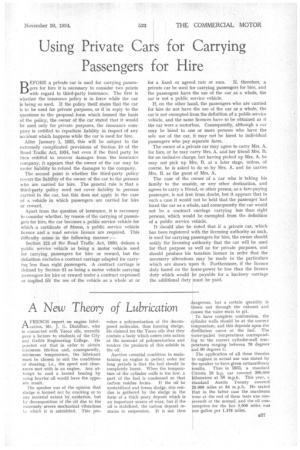A New Theory
Page 55

If you've noticed an error in this article please click here to report it so we can fix it.
of Lubrication
AFRENCH expert on engine lubrication, Mr. J. G. Dintilhac, who is connected with Yacco oils, recently gave a lecture to students of the City and Guilds Engineering College. He pointed out that in order to obtain minimum friction and, consequently, minimum temperature, the lubricant must be chosen to suit the conditions of shearing, Le., the speed and clearances met with in an engine. Any attempt to cool a heated bearing by using heavier oil would have the opposite result.
The speaker was of the opinion that sludge is formed not by cracking or to any material extent by .oxidation, but by decomposition of the oil due to the extremely severe mechanical vibrations 1.0 which it is submitted. This pro
yokes a polymerization of the decomposed molecules, thus forming sludge. He claimed for the Yacco oils that they contain a body which comes into action at the moment of polymerization and renders the products of this soluble in the oil.
Another essential condition in maintaining an engine in perfect order for long periods is that the fuel should be completely burnt. When the temperature of The cylinder walls is too low, a part of the fuel is condensed so• that carbon residue forms. If the oil be unstabilized and forms sludge, this residue is gathered by the sludge in the form of a thick pasty deposit which is an important source of wear, but if the oil is stabilizer], the carbon deposit remains in suspension. It is not then
dangerous, but a certain quantity is blown out through the exhaust and causes the valve seats to pit.
' To have complete combustion, the cylinder walls should be at the correct temperature, and this depends upon the distillation curve al the fuel. The water-jacket temperatures corresponding to the correct cylinder-wall temperatures ranging between 70 degrees and 80 degrees C.
The application of all these theories to engines in actual use was stated by the speaker to have given extraordinary
results. Thus in 1933, a standard Citroen 10 h.p. car covered 300,000 kilometres at 58 m.p.h. This year, a standard Austin Twenty covered 25,000 miles at 84 m.p.h. He stated that in the latter case the maximum Wear at the end of these tests was oneeventh ot the normal, and the oil con
!
umption for the last 3,000 miles was tie gallon per 1,478 miles.
B37




































































































